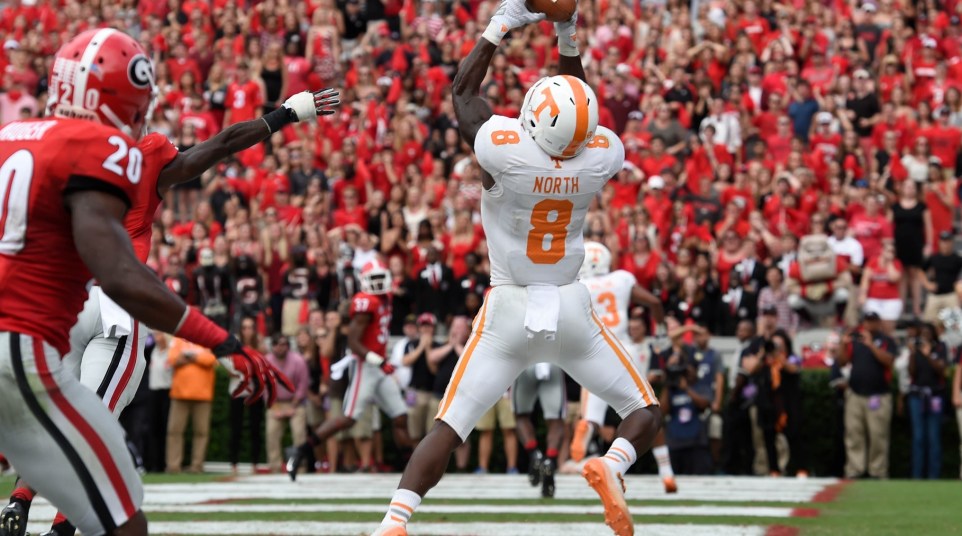Comparing Tennessee's WRs: '15 vs. '98
Heading into the third year of the Butch Jones era, already we’re starting to see “Tennessee” and “championship” associated in the same sentence, with some predicting the Vols will vault to the top of the SEC East in 2015.
That got us thinking: How does this team’s group of receivers compare to the last UT team that won a national championship in 1998?
We’re not suggesting the Vols will (or should) win this year’s College Football Playoff. But it is receivers week at SDS, and it seems like a good opportunity to look back on the glory days of the UT program.
To start, the offense on that ’98 team centered around a harrowing rushing attack. The backfield talent compared to any of the loaded Alabama, Georgia or LSU running back groups in recent years. The Vols featured two future Pro Bowlers in Travis Henry and Jamal Lewis. Henry ran for 970 yards in ’98 as the lead back, while Lewis averaged a team-best 6.8 yards per carry.
Travis Stephens, a future fourth-round pick who broke Tennessee’s single-season rushing record in 2001, also got more than 100 carries, and quarterback Tee Martin scrambled often himself.
The Vols didn’t put up huge numbers in the passing game — Martin threw for just 2,164 yards, and other players threw just eight passes — but not due to lack of talent. No. 1 receiver Peerless Price caught 61 passes for 920 yards and 10 touchdowns, an explosive big-play threat who put together a solid NFL career. In the ’98 national championship game, he caught four passes for 199 yards and the game-deciding touchdown.
No. 2 option Cedrick Wilson averaged 16.9 yards per catch, an exorbitant figure in a run-heavy offense. Another future NFL receiver, Wilson caught 33 passes and scored six touchdowns in ’98. Interestingly, Price was 5-foot-11 and Wilson was 5-foot-10, both crafty players who lacked the overall physical prowess of some of today’s wideouts, but still managed great careers.
The third option, Jeremaine Copeland, was the big target at 6-foot-2. He also averaged more than 15 yards per catch and went on to a professional career, mostly in the CFL.
Overall, the ’98 receivers weren’t the focal point of the offense, and the team threw about half as much as it did the year before with Peyton Manning. But the team’s top two options were sure-handed and dangerous, and both could’ve been 1,000-yard guys in a different offense.
The ’15 Vols probably don’t have two players as talented as Price and Wilson, but have a chance to be much, much deeper at the position.
Tennessee returns its top seven receivers from last year, starting with senior Pig Howard, an above-average player from the slot who won’t put up huge yards per catch, but will track a lot of footballs.
The key player, though, is Marquez North. He fought through foot and back problems last year before a shoulder injury eventually ended his season and required surgery. A potential star at 6-foot-4 and 221 pounds, North should be limited during spring practice. The Vols need him healthy in the fall if the receiving corps is to reach its potential.
Speaking of health, junior college transfer Von Pearson and the 6-foot-5 Jason Croom and four-star ’14 signee Josh Malone, all tremendous athletes, also dealt with injuries during the ’14 season. If they’re the team’s third, fourth and fifth options, you’d better hope you have at least five above-average SEC defensive backs, or some receiver is coming open.
There are other returning options as well, but the other intriguing player is five-star true freshman Preston Williams, another tall, lanky wideout at 6-foot-4 and 191 pounds coming out of high school.
Overall, the ’15 receivers at Tennessee are much, much taller. Seemingly every player is at least 6-foot-3. It would be tough for the group to match the top-end talent of ’98 without some major progress. Health concerns for almost every one of last year’s receivers is worrisome, but if most of them stay on the field, Tennessee potentially is seven or eight deep at the position.
The ’15 offense has the potential to look pretty similar to ’98 in some ways, with Jalen Hurd and Alvin Kamara providing a two-headed attack in the backfield and quarterback Joshua Dobbs more than capable of making some plays with his legs. But the more effective Dobbs becomes at reading defenses and getting rid of the ball quickly behind what should be an improved but questionable offensive line, the better the offense will be.
Tennessee has a slew of athletes that can catch the ball and turn upfield. And considering the ever-improving, nasty defense Jones has developed, if the line can buy time for Dobbs to operate, the quarterback converts his intelligence to football smarts and the receivers stay healthy, we could see another banner year for the Vols at receiver.

